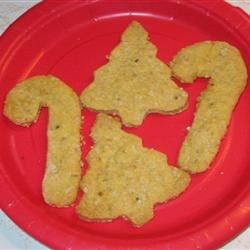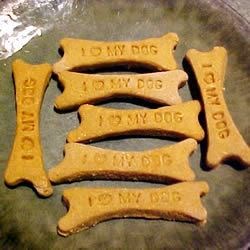Your puppy will accept a lead (leash) much more readily if you introduce it gradually. Under your supervision, begin by letting your puppy drag the lead around the yard to get him used to the feel of minor pressure on his neck. As he walks around, follow him, then gently pick up the lead and walk with him. Keep the lead held high and speak in a friendly, encouraging manner as you walk.
At this early stage, do not look for the disciplined precision of a formal heel. Your goal is simply to get your pup comfortable with the leash and to walk with you without resistance. If he starts to pull out in front, gently reverse your direction and make a noise to distract your pup. No verbal commands should be used during this introduction. You are simply helping your puppy become accustomed to the weight and feel of the lead.
Taking the time to properly introduce your puppy to the collar and lead sets the stage for teaching your puppy the basic elements of obedience. The goal is to have your puppy accept a collar and lead calmly, without resisting.
For puppies, collars and leads with lighter hardware (buckles, snaps, and rings) are best. When grown, you can replace with heavy-duty hardware if appropriate for your breed. Be sure to check your puppy's collar size frequently and loosen it as your puppy's neck grows.
This detailed overview of the different types and designs of collars, leads, and leashes will help you choose the right style and material for your particular dog.
Different Types of Collars
Cotton Web: Cotton web collars are a lightweight, inexpensive choice used primarily for puppies in training. Not as strong as other choices, they tend to show wear more quickly than other material.
Nylon: Nylon collars are available in single-ply or double-ply thickness in a wide choice of colors. An excellent choice for most dogs, they are strong and have a long life. Choose a wider width and thicker styles for larger, stronger dogs.
Leather: Leather collars are very strong, attractive, and last many years. Leather retains its good looks and even improves with age.
Center Cord: The nylon cord is wrapped in either rolled leather or fabric. Also used in retractable leads with excellent strength characteristics.
Hardware: Solid brass is very strong and retains its attractive gold finish forever. Nickel-plated steel are for pet owners who prefer silver color, or choose brass plated. Swivel snap clasps on leads and turn with pets to reduce tangling. Collars -- Choose Traditional Buckle Collars with D-Ring in front, which allows hardware to hang freely under neck, or O-Ring in back for quick attachment. Lightweight yet strong, Quick-Klip Collars offer easy on/off convenience for pet owners who frequently take collars on and off.
Leads (Leashes)
All pet owners should have a 6-foot lead for training and restraining that matches collar style. Almost all proper training is centered around having control of your dog. Leads are the only way to maintain in-close control.
Retractable Leads: are an excellent product for play time or come training as they allow up to 26 feet of freedom to roam and investigate smells, yet still keep the owner in control. Simple, push-button control lets you extend distance, lock desired length in place, and rewind slack.
Collars
There are many styles of collars to choose from depending on your dog's size and disposition, and your training need. For the majority of dogs, a traditional nylon or leather collar is sufficient. Other collars for specific situations are described below. This discussion does not include remote training collars.
Traditional Collars: Traditional collars are available in a variety of styles, colors, and widths and should ride high on your pet's neck, not loose so that it slides down near the top of his shoulder blades. Use a tape measure to measure your pet's neck, then add on two inches.
Collars should be snug with enough room to fit two fingers between your dog's neck and his collar. For your dog's safety, the collar should not be loose enough to slip over the pet's head. In addition to the risk of losing a pet that gets away, loose collars are more easily snagged on objects, and many pets die every year from accidental hanging. For this reason, collars should not be worn in wire cages. Collars should also not be so tight as to restrict breathing or cause coughing. Check collar size frequently on growing puppies.
Choose collar and lead width with hardware that matches pet's size. Smaller, lightweight choices are for small dogs and puppies, and wider, more durable styles are for bigger, stronger pets.
Every collar you own should have a current name tag attached to it at all times.
Harnesses: Harnesses, which go around the neck and around the shoulders behind the front legs, are recommended for dogs who have upper respiratory disease or diseases of the throat or trachea, such as a collapsed trachea. If a dog with an incorrectly fitted collar pulls on the leash, it places pressure on the throat and trachea, causing irritation and coughing. Harnesses relieve that pressure. However as all dogs pull with their chest, harness allow the dog to pull easily.
 Martingale Collar: A martingale collar is made with two loops. The large loop is placed around the dogs neck and adjusted to fit loosely. The leash is then clipped to the D ring on the small loop. When the dog tries to pull their head out of the collar, the tension on the leash pulls the small loop taunt, which makes the large loop smaller and tighter on the neck-- preventing escape. When adjusted properly the dog is never choked, but the collar stays snug around the dog's neck (just behind the ears) until the pressure is released.
Martingale Collar: A martingale collar is made with two loops. The large loop is placed around the dogs neck and adjusted to fit loosely. The leash is then clipped to the D ring on the small loop. When the dog tries to pull their head out of the collar, the tension on the leash pulls the small loop taunt, which makes the large loop smaller and tighter on the neck-- preventing escape. When adjusted properly the dog is never choked, but the collar stays snug around the dog's neck (just behind the ears) until the pressure is released.
 Halter-type Collars: will give you the best control over your dog. They give you control of your dog's head and when you have control of the dog's head, you have control of the dog. There are several brands of these halter-type collars including Halti collar and Gentle Leader. These collars look more like a horse's halter, with a band going around the back of the head, and another around the nose. The leash snaps onto the collar under the chin. When you pull on the leash, the dog's head will either be pulled down or to the side - this makes it virtually impossible for the dog to move ahead or pull you forward.
Halter-type Collars: will give you the best control over your dog. They give you control of your dog's head and when you have control of the dog's head, you have control of the dog. There are several brands of these halter-type collars including Halti collar and Gentle Leader. These collars look more like a horse's halter, with a band going around the back of the head, and another around the nose. The leash snaps onto the collar under the chin. When you pull on the leash, the dog's head will either be pulled down or to the side - this makes it virtually impossible for the dog to move ahead or pull you forward.
Incorrect use of this type of collar can cause, whip lash type injuries and in some cases have actually broken a dogs neck. Proper fitting and handling is required for these type of collars. Some people are hesitant to use the collar since they feel it looks more like a muzzle than a collar.
 Chain-slip Collars: Chain-slip collars, also called check chain or 'choke collars,' provide effective training and retraining tools when used correctly and on appropriate dogs. These collars are most often used for dogs that are strong-willed, pull when on a lead, or those that do not respond to training when wearing traditional collars.
Chain-slip Collars: Chain-slip collars, also called check chain or 'choke collars,' provide effective training and retraining tools when used correctly and on appropriate dogs. These collars are most often used for dogs that are strong-willed, pull when on a lead, or those that do not respond to training when wearing traditional collars.
If you plan to use a choke collar on your dog, have a trainer show you how to use it correctly. Correct usage involves a quick 'tug-and-release' action (as opposed to a steady pulling) that tells the pet a different behaviour is desired. These collars should only be worn during training sessions, never in a crate, and avoided in pets with delicate tracheas, such as Yorkshire Terriers.
For correct sizing, measure your pet's neck and add half that measure again". There is a right and wrong way to put a slip collar on a dog. To correctly place a collar on a dog, the top ring on a properly-looped collar forms a letter P when you stand in front of the dog and pull it snug. If it forms the number 9, it is on backward and may not release immediately as designed, which may cause discomfort or gagging.
 Pronged Collars: Pronged Collars, also called pinch collars, contain blunt prongs that protrude inward from the links. Designed for only the most stubborn pullers, they are temporary training tools used to change behaviour on dogs that do not respond to any other collar. Halter-type collars give you more control and are much less likely to harm your dog.
Pronged Collars: Pronged Collars, also called pinch collars, contain blunt prongs that protrude inward from the links. Designed for only the most stubborn pullers, they are temporary training tools used to change behaviour on dogs that do not respond to any other collar. Halter-type collars give you more control and are much less likely to harm your dog.
We have found that owners who know how to correctly train dogs rarely need these types of collars. Rather, they learned they were training their pet incorrectly, and were able to successfully train their dog using other collars after learning proper methods.
 Ingredients
Ingredients













